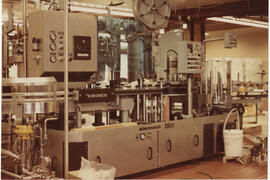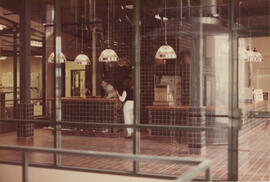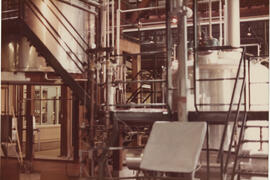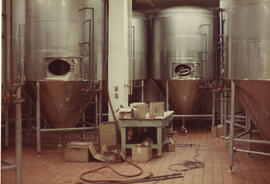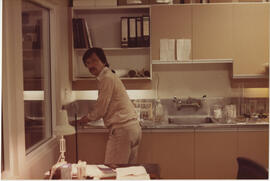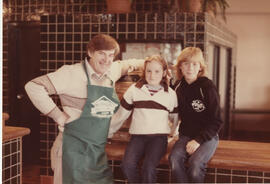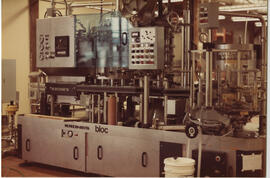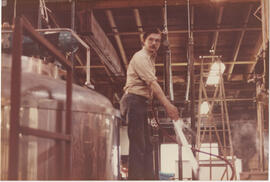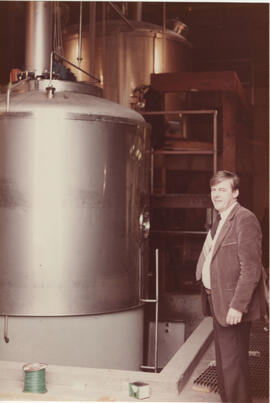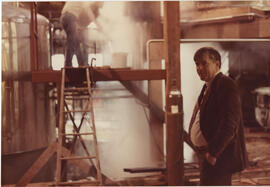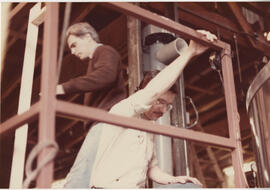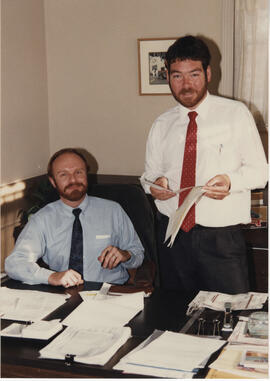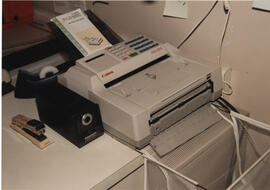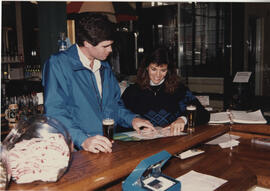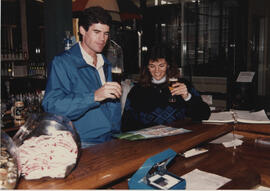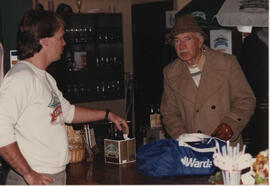Title and statement of responsibility area
Title proper
Granville Island Brewing Company Limited records
General material designation
- Textual records
- Photographic materials
- Artefacts
- Graphic materials
Parallel title
Other title information
Title statements of responsibility
Title notes
Level of description
Series
Reference code
Edition area
Edition statement
Edition statement of responsibility
Class of material specific details area
Statement of scale (cartographic)
Statement of projection (cartographic)
Statement of coordinates (cartographic)
Statement of scale (architectural)
Issuing jurisdiction and denomination (philatelic)
Dates of creation area
Date(s)
-
1984-2013 (Creation)
- Creator
- Granville Island Brewing Company Limited
-
1984-2013 (Creation)
- Creator
- Taylor, Mitch
Physical description area
Physical description
20.5 cm of textual records
4 cm of graphic material
63 photographs: prints
25 photographs: negatives ; 35 mm
1 contact sheet
114 artefacts
Publisher's series area
Title proper of publisher's series
Parallel titles of publisher's series
Other title information of publisher's series
Statement of responsibility relating to publisher's series
Numbering within publisher's series
Note on publisher's series
Archival description area
Name of creator
Administrative history
Canada’s first licensed microbrewery, Granville Island Brewing (GIB) officially opened its doors on June 9, 1984. However, the planning began several years earlier in 1981, when business partners Mitch Taylor and Bill Harvey were seeking out a new venture. Nearly a decade had passed since the pair had established The Creekhouse on Granville Island in 1972 and False Creek Marinas in 1973, paving the way for other businesses and the revitalization of the area.
Although at the time the BC beer market was dominated by the ‘Big Three’ (Molson, Labatt’s and Carling O’Keefe), Taylor and Harvey were inspired by the opening of an English-style ale brewpub, Horseshoe Bay Brewing in 1982, to establish a German-style lager craft brewery. Located at 1441 Cartwright Street, in an old warehouse in a high traffic area near the entrance to Granville Island, the proposed brewery would produce premium, unpasteurized beer to sell through its own retail store for at-home consumption as well as through the government liquor
stores and other licensed premises in the Lower Mainland. At the time, Granville Island received six million visitors per year (both tourists and locals) and had no liquor retailers although it did have six licensed restaurants.
In order to brew this premium lager, the pair decided that they should hire a German braumeister to direct the brewing process according to the Bavarian Purity Law. They travelled to Germany, selecting three brewers to visit Vancouver to compete for the honour. The successful candidate was Rainer Kallahne from Aalen, who had received his braumeister diploma from the University of Berlin and was assistant brewmaster at Koepf Breweries.
In addition to Taylor and Harvey, initial partners in Granville Island Brewing Company Limited were: former McDonald’s marketing vice president Larry Sherwood, in charge of marketing; UBC engineering professor Bob McKecknie, for engineering; lawyer Ian Robertson, for the legal work; and Ted Reichgeld, a building engineer and developer in charge of construction. The first five directors of the company were: Mitch Taylor, Ian Robertson, Robert Paterson, Norman Ross and Robert Hunt.
With personal equity, bank debt and a Limited Partnership, construction of the $3 million brewery building designed by Peter Busby began in the fall of 1983. The brewhouse equipment was sourced from the UK, the stainless-steel tanks from the Fraser Valley and the Krones bottling line and bottle washer from Germany. The brewery used fifteen 60 hectolitre aging tanks, with an initial capacity of 5,000 hectolitres or 125,000 cases per year.
After two years of negotiations with the BC Liquor Control and Licensing Branch, Granville Island Brewing Company Limited received its brewer’s license on January 18, 1984, becoming the first licensed microbrewery in Canada. When GIB opened its doors in 1984, it offered one beer: Island Lager. The first batch was produced in the spring of 1984 (brewing began in April), and it took a total of six weeks before it was shelf ready. Once the beer was produced it had a shelf life of only 60 days due to the lack of preservatives.
In June 1984, the first sales of 5.0% Island Lager were made in the GIB retail store, costing consumers $4.40 for a four pack and $12.50 for a twelve pack. In addition to onsite sales, Island Lager was sold at local pubs, restaurants and cold beer stores throughout the lower mainland. In the first seven months of operation, 40,000 dozen bottles were sold. Brewery merchandise and souvenirs were also sold at the store and free tours of the brewery were offered throughout the day, making it a popular tourist destination. With the addition of Okanagan wine sales in April 1985, the store was allowed to open on Sundays (the only place in Vancouver where one could buy beer on that day of the week) and long lineups were a regular occurrence. By December 1988, GIB beer was carried in 120 provincial government liquor stores, 40 cold beer and wine stores and approximately 600 licensed establishments throughout British Columbia.
Island Lager would be joined in April 1985 by the seasonal Island Bock, which became a permanent product in 1987, the 4% Island Light in May 1988, and Lord Granville Pale Ale circa 1991. Island Marzen was first produced for Granville Island’s 10th anniversary in 1988, and was kept on as a seasonal beer. The beer was sold in unique, tall necked bottles, more similar to imported beers than the stubby bottles preferred by the large brewers of the time. In May 1986, GIB began offering draft Island Lager in a take home Party Keg. The insulated kegs came in 10L, 15L and 20L sizes.
In December 1986, GIB signed a supply agreement with California’s Pasadena Beer Company and began exporting their beer as Pasadena Lager. In 1987, GIB sold 800 hectolitres to Pasadena Beer Company included in total sales of 6178 hectolitres of packaged and 4457 hectolitres of draught . Plans in 1986 and 1987 for an “Island Alt” ale, with reduced aging time, never came to fruition but an “ale” named Lord Granville Pale Ale was showcased at "A Celebration of Beer" on March 20, 1991.
Eventually, Bill Harvey pulled out of the brewery operations. Mitch Taylor continued as President and CEO until 1989 but was unable to make the brewery financially sustainable at its initial scale of production and with the constraints of the lager’s long aging cycle. For several years, he sought additional investors and for a time he took the business public on the Vancouver Stock Exchange. In 1989, Taylor accepted an offer from International Potters Distilling (owner of Calona Wines and Pacific Western Brewery) for a share exchange with GIB. This reduced Taylor’s shares from a majority position in GIB to a much smaller minority position in Potters. He remained involved with GIB for another three years, taking on the position of VP Sales and Marketing for Potters before resigning and selling his shares in 1992.
Under Potters’ ownership, the aging tanks capacity was doubled to 120 hectolitres, and in 1993 GIB became the first microbrewery to use cans. Production was moved to Kelowna, BC in the early 1990s. In August 2005, GIB was purchased by Andrew Peller Wines, and in 2009 it was acquired by Creemore Springs, a subsidiary of Molson Coors Canada, which still owned the brewery as of August 2023.
Name of creator
Biographical history
Mitchell J. (Mitch) Taylor was born on September 7, 1944 to Thomas and Florence Taylor, in Fort Frances Ontario. He was the fifth of the couple’s nine children. In 1952, at the age of seven, Taylor and his older brother Bob went to live with Alexander and Winnifred Brown on their farm near Regent, Manitoba to attend school and help on the farm.
Taylor lived with the Browns until the fall of 1962, when he began Bachelor of Science studies at the University of Manitoba. During the summers he held various jobs, including sweeping up nickel dust at the International Nickel Company of Canada mine smelter in Thompson, Manitoba and welding assistant on the TransCanada natural gas pipeline in Saskatchewan. After graduating from university in 1965, Taylor travelled through Europe before securing a job with Imperial Oil as an Industrial Sales Representative based in Kamloops, B.C.
On June 10, 1967, Taylor married Anne Franklin, his former classmate at Dand High School and a recent University of British Columbia graduate. The couple later had two daughters, Lydia and Jillian. The Taylors initially lived in Kamloops, with Anne teaching school locally. In 1969, Taylor became BC sales manager for Imperial Oil and was transferred to the Vancouver head office. He was promoted to a financial analyst role for the province in 1970, and in 1971 he became the Assistant to the Petroleum Products Committee of Imperial Oil, based in the Toronto office.
In 1972, Taylor resigned from Imperial Oil to embark on a new business venture in Vancouver with partner Bill Harvey. Purchasing the former Monsanto Chemical buildings on Granville Island for $18,000.00, the partners established Creekhouse Industries. They also received approval to build a 400-berth marina on the north shore of False Creek, west of the Cambie Street Bridge. While successfully lobbying for the revitalization of Granville Island, Taylor and Harvey fully renovated the Monsanto buildings, opening them as The Creekhouse in the winter of 1972. Their second venture, False Creek Marinas, began operations the following year in 1973 and immediately had a waitlist. After more than a decade of success, the land it occupied was expropriated by the BC government for Expo 86 and the marina was demolished.
By 1981, Harvey and Taylor were looking for a new business venture and they settled upon the establishment of a German-style lager craft brewery on Granville Island. The first microbrewery in Canada, Granville Island Brewing (GIB) was officially opened on June 9, 1984, with a German, Rainer Kallahne, as brewmaster. It had an initial capacity of 5000 hectolitres (125,000 cases) of beer per year. Bill Harvey eventually pulled out of the brewery operations. Taylor continued to operate as President and CEO until 1989, when International Potters Distilling (owner of Calona Wines and Pacific Western Brewery) did a share exchange with GIB. This reduced Taylor’s shares from a majority position in GIB to a much smaller minority position in Potters. Taylor remained involved with GIB, taking on the position of VP Sales and Marketing for Potters for three years before resigning and selling his shares in 1992. Additional information about Granville Island Brewing can be found in Series F-329-4 Granville Island Brewing Company Limited records.
In January 1995, Taylor purchased Bellingham Marine Industries, becoming the company’s President and CEO. Under his ownership, the company expanded to twelve plants in eight countries and became a world leader in marina design, engineering and construction by the time Taylor sold it in 2006. From 2006 to 2016, Taylor sat on the Board of Directors for The Knowledge Network, and from 2009 to May 2017, Taylor was co-owner of Knight Signs in Delta, BC. Through all of this time, he has retained an ownership position in Creekhouse Industries. In 2021, Mitch Taylor wrote and published his autobiography titled Making Way: A Memoir, which details his personal and professional experiences to that time.
Custodial history
Scope and content
Series consists of records relating to the founding, development, administration and operation of Granville Island Brewing Company Limited during the time of Mitch Taylor’s involvement with the company. Types of material include reports; policy and procedure documents; photographs; promotional material; press clippings; and artefacts such as beer bottles, tap handles, kegs, glasses and t-shirts.
The series is arranged into seven sub-series:
Notes area
Physical condition
Immediate source of acquisition
Arrangement
Language of material
- English
Script of material
Location of originals
Availability of other formats
Restrictions on access
Terms governing use, reproduction, and publication
Copyright ownership is mixed; see the note on Terms governing use in the fonds-level description. See sub-series descriptions for more detailed information.
Finding aids
Generated finding aid
Associated materials
Accruals
Alternative identifier(s)
Standard number area
Standard number
Access points
Subject access points
Place access points
Name access points
- Granville Island Brewing Company Limited (Subject)
- Taylor, Mitch (Subject)
Genre access points
Control area
Description record identifier
Institution identifier
Rules or conventions
Status
Final
Level of detail
Full
Dates of creation, revision and deletion
Language of description
- English






